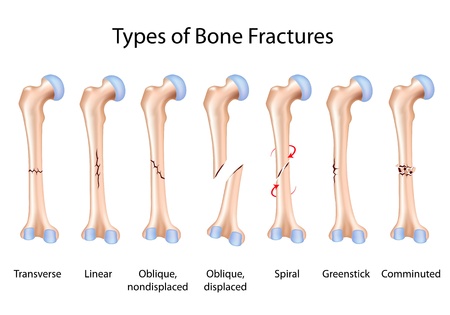
This is a medical condition characterized by breakage of the bone. A broken bone or fracture occurs when excessive force is applied to your bone that causes the bone to break or shatter. Fractures are of different types, there are some that completely break the bone, while others only cause a crack in the bone. The types of fractures vary depending on the circumstances of the injury and the amount of force applied to the bone.
Causes of Fractures
You can break your leg in many ways, including:
1. Falls. A simple fall can break one or both of your leg's bones. However, it is unlikely that the femur will be broken without a larger trauma.
2. Road accidents. There are three bones in the leg which can break during a motor vehicle accident. When your legs collide with another object during a collision, it can lead to fracture.
3. Sports injuries. During sports, when the leg is extending beyond its limit, it can break the leg. So also a direct hit to the leg for example from a hockey stick or from the body of an opponent.
4. Child abuse. In kids, a broken leg can occur as a result of child abuse, most especially when the leg of the child has been injured before starting to walk.
5. Excessive use. Stress fractures are small cracks that occur in the bones that bear the weight of the body, including the shinbone. Stress fractures usually occur due to repeated force or excessive use, such as long distance running. But they may also occur during normal use of weakened bone due to conditions such as osteoporosis.
Symptoms of Fractures
The symptoms of bone fractures may vary considerably depending on the affected part, age, general health of the patient and severity of the injury. However, they often include some of the following:
• Pain.
• Swelling.
• Bruise.
• Angulation - the affected area can be bent in an unusual corner.
• The patient cannot put weight on the injured area.
• The patient finds it difficult to move the affected area.
• The affected part of the bone or joint may have a grafting sensation.
• Bleeding may occur in cases of open fracture.
• When a large bone is touched, such as a pelvis or a femur:
o The victim may look pale and clammy.
o There may be dizziness (feeling of unconsciousness).
o There can be feelings of illness and nausea.
If possible, make sure that the injured person is not moved with the broken bone until the health care professional is present and can assess the situation and, if necessary, apply the treatment. If a patient is in a dangerous place, for example in the middle of a busy road, it may be necessary to take precautionary measures before the arrival of an emergency service.
Fracture Treatment
Treatment for a Fracture requires restoring the circulation and blood flow to the affected structures in your injured area. Pain is caused when swelling, inflammation and decreased circulation generate a blockage, which causes blood flow to be interrupted or slowed. Treatment for this issue requires breaking up the accumulated fluids in your injured area to allow for improved healing and quicker recovery.
Products recommended for symptoms of swelling, redness, pain, and inflammation, and if coolness makes your pain feel better:
Ice Substitute Poultice
Bruise Relief Liniment
Muscle Therapy Massage Oil
Products recommended when swelling and inflammation are gone, but you still feel pain, stiffness, weakness, and/or sensitivity in cold and damp weather, and if heat makes your pain feel better:
Tendon and Ligament Poultice
Muscle Therapy Massage Oil





